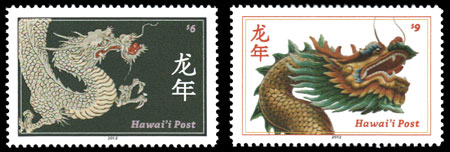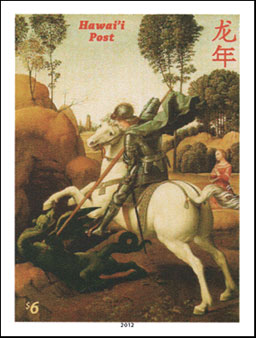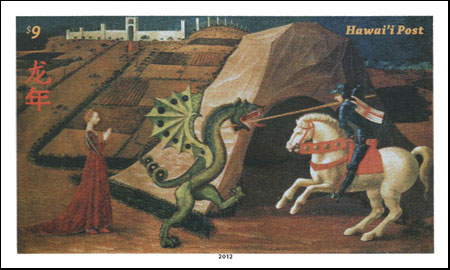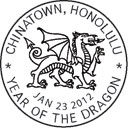.
.
.
.
.
.
.
.
.
.
.
.
.
.
.
.
.
.
.
.
.
.
.
.
.
.
.
.
.
.
.
.
.
.
.
.
.
.
.
.
.
.
.
.
.
.
.
.
.
.
.
.
.
.
.
.
.
.
.
.
.
.
.
.
.
.
.
.
.
.
.
.
January 23rd 2012. Lunar New Year - the Year of the Dragon.
Two stamps and two minisheets were issued on January 23rd 2012 to celebrate the first day of the Lunar New Year, The Year of the Dragon.

The Year of the Dragon began on January 23rd 2012 and ends on February 9 2013.
The $6 stamp (above left) prepays the Overnight rate. It shows a white dragon from part of an 1860 print by the Japanese artist Kunisada. The full-size print depicts the female sage Tai-shin flying across the ocean on a white dragon.
The $9 stamp (above right) prepays the Same Day rate. It shows a dragon from a carving outside a Buddhist temple.
Dragons are mythical creatures and there are different types of dragons. A Japanese dragon has three claws on each foot, the Chinese dragon has five claws and the Korean dragon has four claws. In Europe, dragons are usually considered to be more evil, which is based on the St. George legend (see below).
People born in the Year of the Dragon are achievers. They do things and gain power by getting things done. A dragon can breathe fire so the person born in the Year of the Dragon can be a hothead.. However, the dragon has a soft underbelly and so the person born in the Year of the Dragon can have a "soft spot" to them. They may show anger at someone who annoys them but they can also show great compassion to people in need.
The dragon has a long tongue and so the person born in the Year of the Dragon can have a sharp tongue. They will say things that can be quite sarcastic and biting. A person born in the Year of the Dragon can be quite a formidable person but if you can reach out to their "soft spot", they are worth having as friends or lovers.

The $6 minisheet (above) shows St. George killing the dragon by the reknowned Italian artist Raffaelo Sanzio da Urbino (better known as Raphael. 1483-1520).
The $9 minisheet (below) shows St. George killing the dragon by the reknowned Italian artist Paolo Uccello (1397-1475).

The legend of "St. George and the Dragon" took place in Silene, a town in Libya. Silene had a large lake where the dragon lived. To appease the dragon, the villagers would feed it sheep and maidens from time to time. The village maidens would draw lots to see who would be sacrificed to the dragon.
One day, the lot fell upon the beautiful Princess of Silene. The King offered the villagers all his gold and silver and half of his kingdom if they spared his daughter. The villagers, fearing the wrath of the dragon, refused. So, the Princess went out to the lake to be fed to the dragon.
St. George, upon hearing of the beautiful Princess' fate, rode up on his white horse. The Princess tried to send him away. Just then, the dragon reared it's head out of the lake. St. George charged at it on horseback and pierced it with his lance, but not mortally. They led the wounded dragon back to Silene, which terrified the villagers as they approached. But St. George called out to them, saying that if they converted to Christianity, he would finish off the dragon.
The King and the villagers agreed and were converted to Christianity. St. George then drew his sword and slew the dragon. On the site where the dragon was slain, the King built a church, which had a natural spring whose waters were said to cure all diseases.

The special postmark for this issue (above) depicts a dragon.
WE ACCEPT CREDIT CARDS ON ALL ORDERS
![]()
![]()
![]()
![]()
Technical details of the stamps and mini-sheet:
Colors: $6 & $9 stamps and minisheets - Multicolored.
Stamp size: 48mm x 32mm.
Stamps sheet size: $6 & $9 - 30 (5 across, 6 down).
$6 Minisheet size - 57mm by 76mm.
$9 Minisheet size - 95mm by 57mm.
Stamps perforated 12, minisheets - imperforate
Stamps design: Enelani.
Layout & Pre-press: Enelani.
Printer: Hawai'i Security Printers, Honolulu, Hawai'i.
Printing Method: 4-color (Cyan, Magenta, Yellow and Black) printing process.
Sheet margin markings: HAWAI'I POST (top middle), "Traffic Light" showing 4 colors used in printing (lower left side), © 2012 Hawai'i Post (lower right side) & Hawai'i Security Printers, Honolulu, Hawai'i. (bottom middle)
Paper: GPA coated white stock with water-activated gum on the back.
Return to list of stamp issues
For details on upcoming stamp issues click here